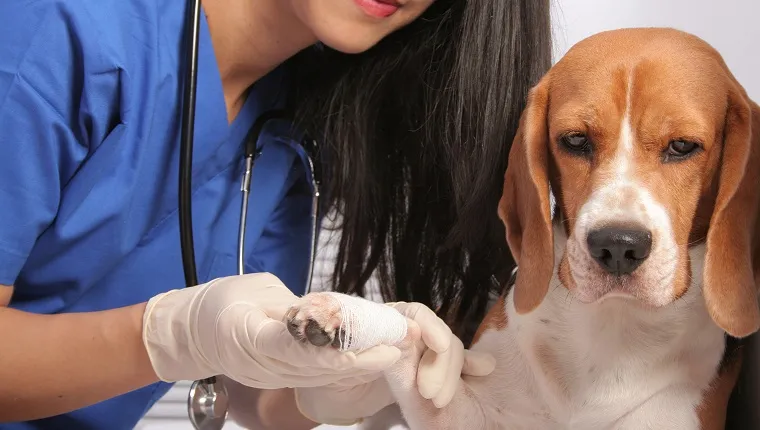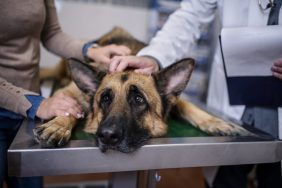A squamous cell carcinoma is a malignant tumor in the epidermal layer of a dog’s skin. It often appears as a mass of white skin or a raised lump that can be directly on a dog’s skin, in the nail beds of the toes, or in the mouth.
The mass may begin bleeding as the condition progresses. Squamous cell carcinomas are malignant, though they metastasize slowly and are more treatable than many other forms of cancer; however, tumors in the nail bed grow more quickly and are more difficult to treat.
If you see any lump on your dog’s skin, nail beds, or mouth, you must get to a veterinarian immediately for a proper diagnosis and treatment. Here’s what you should know about the symptoms, causes, and treatments for squamous cell carcinomas in dogs.
Symptoms Of Squamous Cell Carcinoma In Dogs

Symptoms of squamous cell carcinomas in dogs can vary depending on where the tumor is located. They may also be difficult to spot or distinguish from other sores, ulcers, bumps, or lesions that occur in your dog.
If you see potential signs of a squamous cell carcinoma in your dog, it’s best to have it checked out by a veterinarian who can run tests and form a proper diagnosis.
Here are a few signs of squamous cell carcinomas in dogs:
- Crusty or bleeding sore that doesn’t heal, even with antibiotics or creams
- Sores in areas where fur is white or light in color
- White growths or masses of skin
- Growths on the nose, toes, legs, scrotum, or anus
- Wart-like lumps
- Limping or pain while walking
- Lameness
- Drooling
- Difficulty chewing or swallowing
- Coughing
- Inflammation, bleeding, or swelling in the mouth
- Loose teeth
Causes Of Squamous Cell Carcinoma In Dogs

The causes of squamous cell carcinomas in dogs are somewhat difficult to determine, as there are a variety of genetic and environmental factors that contribute to the development of the condition.
Exposure to ultraviolet light or sunlight is the factor that most people are familiar with. Areas of the body that get more exposure to sunlight, like patches with lightly colored fur or thin coverage, have a higher risk, as do dogs who live at higher altitudes.
There are other factors that make a dog more likely to develop squamous cell carcinomas. Dogs who are aged six to eleven years old and large breed dogs are most at risk. Dogs with compromised immune systems suffer increased risk, as well.
There may also be a connection between squamous cell carcinoma and the papilloma virus.
Breed can affect risk for the condition. Basset Hounds, Collies, Keeshonds, and Standard Schnauzers are predisposed to squamous cell carcinomas of the nail beds.
Dachshunds, Gordon Setters, Labrador Retrievers, Schnauzers, Scottish Terriers, Standard Poodles, and Rottweilers are more likely to develop squamous cell carcinomas on the skin.
English Springer Spaniels and Shetland Sheepdogs are predisposed to squamous cell carcinomas in the mouth.
Treatments For Squamous Cell Carcinoma In Dogs

It’s important for dogs to get treatment for squamous cell carcinomas, as cancer almost never disappears on its own without treatment. A dog’s immune system can kill some cancer cells. However, it rarely kills all of them, and this form of cancer can compromise the immune system.
The most common form of treatment for squamous cell carcinomas in dogs is surgical removal.
There are other forms of treatment for areas of the body where surgery could be dangerous. These methods include cryosurgery, which is freezing the tumor off with liquid nitrogen, phototherapy, or radiotherapy.
In the case of squamous cell carcinomas of the nail bed, one or more toes may need to be amputated. Part of the nose or ear may be removed, as well, if a squamous cell carcinoma appears on those parts of the body.
These are mostly cosmetic alterations, and most dogs recover and live normal lives. Sometimes when a tumor can’t be removed, it will be treated with chemotherapy and radiation. Your vet will be able to determine the best course of action.
Has your dog ever had a squamous cell carcinoma? How did your vet treat your dog? Let us know in the comments below!









